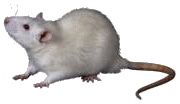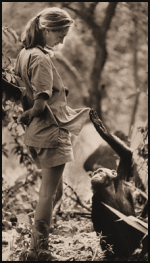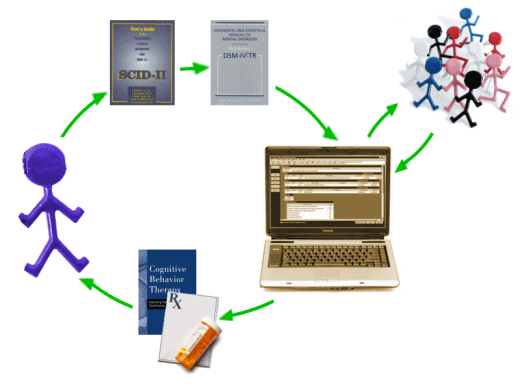 Academic Psychologists have well defined one application of the Scientific Method to the study of we animals. Classically, there are two indentical groups, save for a single parameter. Anterior to the study, the Investigator declares the outcome measurement. So:
Academic Psychologists have well defined one application of the Scientific Method to the study of we animals. Classically, there are two indentical groups, save for a single parameter. Anterior to the study, the Investigator declares the outcome measurement. So:-
we record the baseline measurement [to assure the groups are the same]
-
we introduce the change in the parameter into one group only
-
we record the endpoint measurements
-
we analyze the group differences
 The Naturalists of the nineteenth century who were studying the variations in nature and used a different approach. Their extensive detailed observations resulted in the classifications of Botany and Zoology and laid the framework for the evolutionary schemes that followed. The later study of complex animal behavior in the natural environments couldn’t rely the carefully controlled situation of the Psychologist’s laboratory environment, so they adapted the methodology of the naturalists – making their inferences from observations without intervention. These Ethologists found validity in repeated observations of behavior patterns over long periods of time – carefully isolating similarities from the complex variability of the natural world. The Paleontologists spend their lives looking for a tiny yield – a partial skeleton here and there. But by comparing their precious pieces of evidence with each other and contemporary structures, they have produced an increasingly clear picture of man’s developmental history. And so it goes as the scientific method is adapted to the object and situation of study.
The Naturalists of the nineteenth century who were studying the variations in nature and used a different approach. Their extensive detailed observations resulted in the classifications of Botany and Zoology and laid the framework for the evolutionary schemes that followed. The later study of complex animal behavior in the natural environments couldn’t rely the carefully controlled situation of the Psychologist’s laboratory environment, so they adapted the methodology of the naturalists – making their inferences from observations without intervention. These Ethologists found validity in repeated observations of behavior patterns over long periods of time – carefully isolating similarities from the complex variability of the natural world. The Paleontologists spend their lives looking for a tiny yield – a partial skeleton here and there. But by comparing their precious pieces of evidence with each other and contemporary structures, they have produced an increasingly clear picture of man’s developmental history. And so it goes as the scientific method is adapted to the object and situation of study.
While the scientific method unites the scientific disciplines, the thing that defines a science is neither its specific tools and methods nor its hypotheses and theories, it’s the data-set itself – the object observed, the evidence. Chemistry, Physics, Botony, Zoology, Psychology, Ethology, Paleontology, etc. – the list is long. The applied sciences like Medicine are hybrids that reach into many basic sciences [and create some of their own] looking for tools to bring to bear on the broad problem of human suffering.
The complexity and subjectivity of mental illness has sent Psychiatrists searching far and wide for explanations and treatments – focusing on behavior, emotional experience, the mind, the brain, patterns of illness, etc. The Psychoanalysts took as their data-set the private stream of consciousness. The Behaviorists looked to learning theory. Almost everyone focused on the reported emotions or mood. The Neurobiologists looked at the Brain and its neurochemistry. It’s been something of an "any port in the storm" narrative with more than its share of twists and turns.
 When the psychiatry decided to create an atheoretical classification of Mental Disorders [DSM III, 1980], there were many forces at work. I’ve given some takes on how that worked [evidence-based medicine III: DSM III and later…], and I would particularly recommend Dr. Bernard Carroll’s comment a few post back. He was there when it happened and brings a depth of perspective that I don’t have. My personal reaction back then was that it was arbitrary, not much help, and showed too many signs of our internal divisiveness. But I didn’t much care. I assumed that it was a first pass that would evolve based on its clinical usefulness and shortcomings. I’m not even sure I noticed how symptom-based it really was. But I was certainly very wrong about what would happen.
When the psychiatry decided to create an atheoretical classification of Mental Disorders [DSM III, 1980], there were many forces at work. I’ve given some takes on how that worked [evidence-based medicine III: DSM III and later…], and I would particularly recommend Dr. Bernard Carroll’s comment a few post back. He was there when it happened and brings a depth of perspective that I don’t have. My personal reaction back then was that it was arbitrary, not much help, and showed too many signs of our internal divisiveness. But I didn’t much care. I assumed that it was a first pass that would evolve based on its clinical usefulness and shortcomings. I’m not even sure I noticed how symptom-based it really was. But I was certainly very wrong about what would happen.
I think I learned how important nosology [classification] is to science through all of this, because these collections of symptoms with rigid diagnostic criteria began to be treated as if they were diseases of the type that either have known causes, or are syndromes whose etiology is unknown but are considered distinct clinical entities. And in spite of disclaimers along the way, that hasn’t changed much in the last 30 years. I guess I had thought of Psychiatric Disorders as having a few nouns, and a lot of adverbs, adjectives, phrases, or even, paragraphs. In the DSM grammar, most everything is a noun. And in this universe of psychiatric nouns, everything else began to cluster around. Research became monotonous, modeled on the academic psychology animal room with clinical trials of various treatments [usually drugs] in diagnostic groups whose outcome evidence was symptom relief. Structured interviews were devised to insure diagnostic reliability [instead insuring the persistance of the nosology]. Treatment regimens became categorical algorithms [also used for insurance purposes].
 To my mind, the resulting evidence-based psychiatry seems like a tautology from my college logic class. A tautology is neither a proof nor fallacy. It’s the situation where the premise and the conclusion are just different ways of saying the same thing. Instead of experience informing, refining, or changing our new classification, practice was being designed to reaffirm and solidify it, since the only admissable evidence is group validation by clinical trial. No matter the outcome of the study, the validity of the group is affirmed. It depersonifies our patients – their diagnoses becomes bigger than their lives or experiences, and it locates the seat of knowledge outside the clinician/patient dyad, putting it in the hands of key opinion leaders who look at the studies and create the algorithms. The resulting relationship moved from doctor/patient to expert/diagnostic_group. I wish I were overstating this, but I don’t think I am by much.
To my mind, the resulting evidence-based psychiatry seems like a tautology from my college logic class. A tautology is neither a proof nor fallacy. It’s the situation where the premise and the conclusion are just different ways of saying the same thing. Instead of experience informing, refining, or changing our new classification, practice was being designed to reaffirm and solidify it, since the only admissable evidence is group validation by clinical trial. No matter the outcome of the study, the validity of the group is affirmed. It depersonifies our patients – their diagnoses becomes bigger than their lives or experiences, and it locates the seat of knowledge outside the clinician/patient dyad, putting it in the hands of key opinion leaders who look at the studies and create the algorithms. The resulting relationship moved from doctor/patient to expert/diagnostic_group. I wish I were overstating this, but I don’t think I am by much.
It’s as if in this system, there’s a great spreadsheet somewhere with the diagnoses heading each column and the treatments labeling the rows. The goal appears to be to get a checkmark in every column. We’re proceeding as if our disorders are well-defined and the only real goal is symptom relief, which we determine by clinical trials with various treatments [drugs]. Our only frontier is then to generate more "novel" treatments to fill in the grid. It’s an unsupportable trajectory that both overstates and simplifies the state-of-the-art, eliminates our Naturalists [the tradition of Adolf Meyer], our Ethologists [psychotherapists], our Paleontologists [analysts], and most of our serious Biologists who would hardly claim that neurobiology is understood at a level that would support the current directions. Worse than that, it has created a stilted scientific environment with an unecessarily constricted view of the scientific method [called evidence-based psychiatry] that has produced almost nothing in the way of creative, innovative, or even clarifying approaches to behavioral science. And these tools, methods, hypotheses, and theories have come to define the specialty, forgetting that the data-set is mentally ill people and their plight.
BRAVO! Beautifully expressed. I really support the “biologists would hardly claim that neurobiology is understood at a level that would support the current direction.” If I recall correctly, Charles Barber, in his book Comfortably Numb, used the metaphor that our current knowledge of the brain is like trying to identify who recovered a fumble at a pro football game from the Blimp.